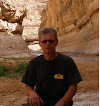Further to southwards

The Rio Punturas Canyon and the UNESCO world heritage site "Cueva de las Manos" (Cave of the Hands) are about 160 kilometres from the small town of Perito Moreno. This interesting place was rediscovered only in 1881.

At the entrance the visitors are accompanied by a guide and the route takes along a path by side of thehill. The first so called “hand-drawings” on the rock are visible in a few hundred meters already.
Here the palm of the left hand is placed against the stone wall and then some paint is blown through a bone pipe on the hand – the result - a negative handprint.

The walls of the rocks are covered with hand trails, there are more than over 2000 of them here and more than 90% of the specimens are of the left hand, and there is even one with six (6) fingers.

Different colours like - dark red, black, yellow and white - are used.. And the traces are really well-preserved.

 And next to the hands there are guanacos - very likely the principal food of the people of that time.
And next to the hands there are guanacos - very likely the principal food of the people of that time.
The drawings date back about 13,000 to 9,000 years, and the majority of them are in a very good condition. The drawings are from three different periods - the oldest (13,000 years) are hunting scenes, the traces of hands are about 7000 years old and the most recent ones depict people, different animals and and abstract shapes.
Further reading about this interesting place: http://en.wikipedia.org/wiki/Cueva_de_las_Manos Wikipedia, but a longer and more detailed review of the history of the drawings can be found on UNESCO's website - http://whc.unesco. org/en/list/936.

And I would like to say that this whole canyon was a place of very special and positive aura. I'm not surprised that people in the past chose just this place to live and again and again came back.

Practical information for the visitors of Cueva de las Manose: the price of the ticket for foreigners is 50 pesos (about 10 USD), the place is open 9 - 19.00, and the guided tours begin every hour.




Patagonian landscape. Something similar was experienced in Namibia, the same spaciousness and breathtaking views.

The road disappears into remoteness , no vehicle is coming - as there is no cloud of dust seen in the distance.

And in some places the Ruta 40 has received a new road surface. Which means that after every 10 kilometres no need to inspect the car whether all the parts of the car are still there.


El Calafate is a small town in Patagonia, which lives mostly on tourism and somehow reminds of an Alps ski resort. Only snow is missing and outside it is + 25 degrees.
In the main street one can see shops selling hiking clothes and hiking gear or shops selling souvenirs. And restaurants. And tourism companies that offer visits to various glaciers.

One of the most popular attractions in Argentina is Perito Moreno Glacier, situated 80 kilometres from here.

Parque National Los Glaciares - entrance of the National Park.

The first look at the Perito Moreno Glacier. The total area of the glacier is 250 km2 and the length is 30 km. Another major difference - when in other places of the world glaciers are shrinking, then the Perito Moreno Glacier is actually growing.

Outside is a beautiful, warm summer day. People walk around dressed in T-shirts but a bit further on there is an ice wall of 70 meters high and 5 kilometres wide. The actual thickness of the glacier is much larger - 170 meters, as more than over 100 meters of ice is under the water. The centre and the edges of the glaciers are moving in different speeds, the central part movies to the lake at a speed of 1.7 meters per day, and the speed of the edges is 0.4 meters per day.

The glacier ends in the lake. Lago Argentino is the largest lake in Argentina, the average depth is 150 meters and the maximum depth of the lake is 500 meters.

Luminous blue ice.

However, it is not allowed to go too close, visitors should stay in the specified secure path.

 Continues
ContinuesCon



No comments:
Post a Comment